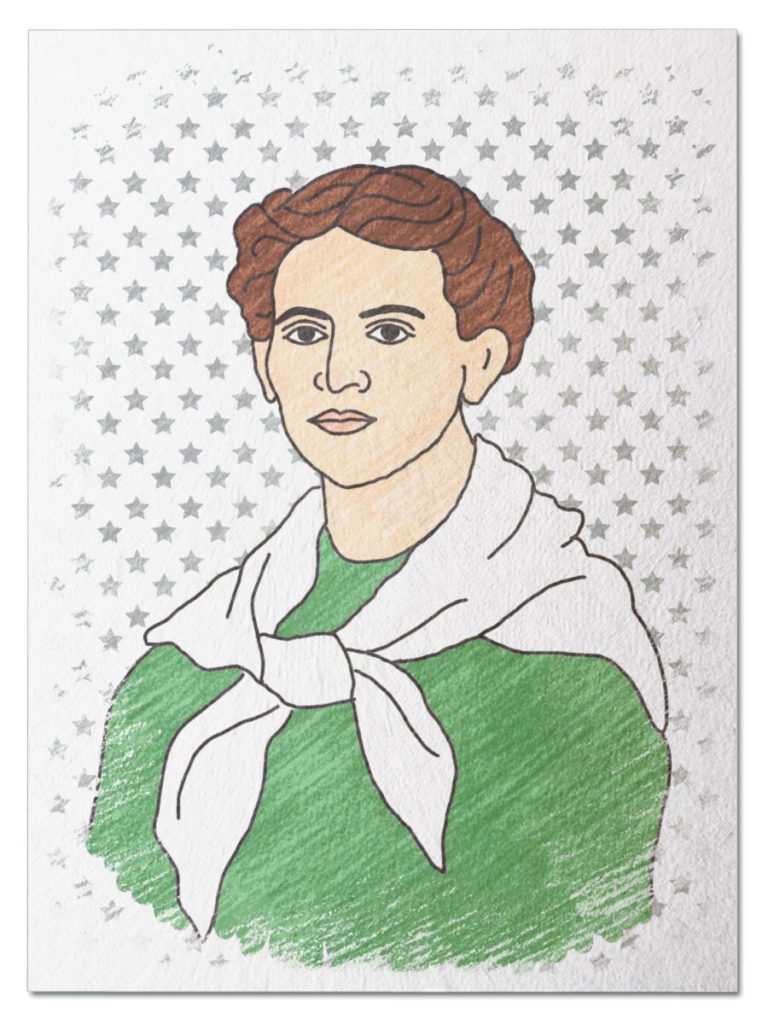
Brilliant Businesswoman
She was only 27 when she risked her life by rowing out in a storm to save two men whose boat had capsized. She was hailed as a hero but viewed it as part of her job as the lighthouse keeper in Newport, Rhode Island. She rejected the notion that saving lives wasn’t “feminine” and eventually became the highest paid lightkeeper in America. Jump into a rowboat on a stormy evening in 1869 and meet Ida Lewis…
Her Ruby Shoe Moment
The Power of the Wand
Her Yellow Brick Road
Brains, Heart & Courage
Glinda’s Gallery
Just the Facts
Her Ruby Shoe Moment
Ida Lewis raced outside and climbed into her rowboat. She didn’t even stop to put on her shoes or coat. It was around 5 pm on March 29, 1869 — a stormy evening. Ida had been sitting peacefully by the fire just minutes earlier. Then, her mother heard cries for help, went to the window, and saw a boat capsized in Narragansett Bay. Two men were being pushed out to sea and would soon drown. It was a race against time.
Ida rowed furiously while the icy waves smashed into the boat. She used every ounce of strength to reach the men in the middle of the Bay. Together, she and her brother, Hosea, dragged the men into the boat. By then, everyone was cold and wet and needed to get to shore fast. It took twice as long for Ida to row back to Lime Rock Island, however — she was already exhausted and had to battle the strong wind.
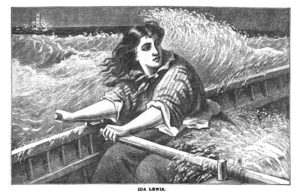 Once they reached the shore, Ida and Hosea carried the men into the house. It took hours before the fireplace for them to all warm up. Ida’s feet suffered from frostbite and the men were in the beginning stages of hypothermia. It was a close call, but she managed to save Sergeant James Adams and Private John McLaughlin.
Once they reached the shore, Ida and Hosea carried the men into the house. It took hours before the fireplace for them to all warm up. Ida’s feet suffered from frostbite and the men were in the beginning stages of hypothermia. It was a close call, but she managed to save Sergeant James Adams and Private John McLaughlin.
The men had been in town and hired a 14-year old boy to row them across the Bay to Fort Adams. The boy wasn’t experienced enough to row in a storm, however, and the boat quickly took on water. Unfortunately, the boy drowned before Ida could reach him. The men spent the night on Lime Rock Island and Ida rowed them to Fort Adams the next day.
To Ida, it was just another day on Lime Rock Island. She had saved five men in the past and would save many more in the future. Rescuing drowning men was a fairly regular occurrence for her. She considered it to be part of the job of tending the lighthouse on the island. To the men, however, she was a hero. And word spread of her rescue.
 Before long, Ida became a local sensation. July 4 was renamed “Ida Lewis Day” in Newport, Rhode Island. She was honored in the town’s parade and over 4,000 people attended, hoping to catch a glimpse of her. During the celebration, Ida was presented with a new rowboat called the Rescue. It was bigger and fancier than her previous rowboat — 14 feet long, with four oars, copper hardware, and red velvet cushions on the benches. Hundreds of people (including President Grant) donated money to purchase the rowboat, which cost about $250.
Before long, Ida became a local sensation. July 4 was renamed “Ida Lewis Day” in Newport, Rhode Island. She was honored in the town’s parade and over 4,000 people attended, hoping to catch a glimpse of her. During the celebration, Ida was presented with a new rowboat called the Rescue. It was bigger and fancier than her previous rowboat — 14 feet long, with four oars, copper hardware, and red velvet cushions on the benches. Hundreds of people (including President Grant) donated money to purchase the rowboat, which cost about $250.
Ida was embarrassed by the attention, however, and refused to speak before the crowd. Instead, Colonel Thomas Wentworth Higgins spoke on her behalf — he expressed her appreciation for the gift and promised to put it to good use. Over 1,000 people assembled on the Long Wharf as the Rescue was put into the water. Around 3:00 pm, cannons boomed and people waved flags as she rowed back to Lime Rock Island.
The Power of the Wand
After her famous rescue, Ida became so popular that people visited the island every day — about 10,000 visitors in 1869 alone. In fact, Elizabeth Cady Stanton and Susan B Anthony visited Ida on the island. They saw Ida as a living example of women’s rights — she did whatever was needed regardless of conventional roles. She entertained them with stories of her rescues and they took delight in the fact that it was a woman who rescued men from the sea.
Every summer, teen girls across America work as lifeguards. The American Red Cross operates a lifeguard certification program, which is open to all teens over 15 years old. Many public beaches and public pools regularly have lifeguards on duty. But what about the safety of kids at private pools? At age 15, Daria Maya started a website to match lifeguards with people who want to keep their guests safe at their pool party. WeLifeguard.com provides a directory of certified lifeguards available to hire for private events. It currently serves the Connecticut and New York communities.
Her Yellow Brick Road
Ida rescued at least 18 people over the course of her career — from inexperienced youth to boat thieves to soldiers to friends. She even rescued a sheep! Ida didn’t record her rescues, however, and some people think she saved closer to 35 people. Ida never shied away from a challenge, even if it put her life in danger. Its thought that she made her last rescue at age 68.
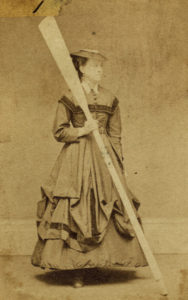
Newport Historical Society
Ida was 16 years old when she made her first rescue. She saved four boys who were her age. They took a friend’s sailboat out one afternoon and had a picnic on a rocky island in the Bay. The wind decreased as they returned, however. So they dropped the sail and planned to float to shore. But then, one boy climbed the mast of the boat and threw it off balance. The boat capsized and the boys cried for help. Ida got there in the nick of time — they were tired from treading water and their clothes weighed them down. She hauled them into the rowboat one by one and brought them to Lime Rock Island. The boys were so embarrassed that they didn’t tell their families until years later.
A few years later, Ida rescued three Irish farmhands. They were herding sheep for a local farmer when one of the sheep wandered onto the wharf and fell in the water. The men jumped into a nearby boat to try to save the sheep. They made the situation worse, however, since they didn’t know how to operate a boat. Once again, Ida raced out to help. She brought the men to shore and then went back for the sheep. She tied the sheep to the boat and dragged it to shore.
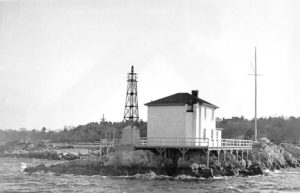
Lime Rock Lighthouse
Over the years, Ida rescued quite a few soldiers. Most of the time, they were crossing the Bay to get back to Fort Adams. Her most dangerous rescue took place on February 4, 1881 — two soldiers decided to take their chances and walk across the frozen Bay. Ida was in the kitchen and saw them across the bay. Then shew heard a loud crack and the men were gone. Ida grabbed a clothesline and raced out to help. She threw them the clothesline, but they both grabbed onto it and overpowered her. She fell into the freezing water as well. Luckily, Ida was able to get herself back up onto the ice. She eventually got them both out of the water, with the help of her brother.
Brains, Heart & Courage
While Ida grew up, she was more comfortable on the ocean than on land. She became the best swimmer in town by age 14. Her father spent his career on the sea and taught Ida all she knew about boats — how to row, how to read the waves and navigate the ocean, and how to rescue a drowning man. She was never formally trained in lifesaving, but her dad taught her well.
 Ida was 12 when her father accepted the position as first lighthouse keeper on Lime Rock Island. It was commissioned in 1853 and construction was completed a year later. At first, there was only a stone tower for the light and a small shanty for supplies. So the Lewis family lived in town and her father rowed out to the island twice per day to tend to the light (the island was about 200 yards from shore). Frequently, Ida joined him for the journey.
Ida was 12 when her father accepted the position as first lighthouse keeper on Lime Rock Island. It was commissioned in 1853 and construction was completed a year later. At first, there was only a stone tower for the light and a small shanty for supplies. So the Lewis family lived in town and her father rowed out to the island twice per day to tend to the light (the island was about 200 yards from shore). Frequently, Ida joined him for the journey.
It didn’t take long for the Lighthouse Board to realize that the light-keeper should live on the island. So they built a two-story house, which included an alcove with glass window panes on 3 sides for an oil burning lantern. The lantern had a Fresnel Lens, which magnified the light and allowed it to travel farther — the light could be seen clear across the Bay.
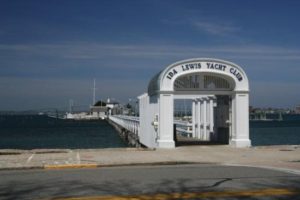
Today, her home is the Ida Lewis Yacht Club
The Lewis family moved to the island on June 29, 1857. Unfortunately, Ida’s father had a stroke about 4 months later. He was partially paralyzed and could no longer do the job. After that, Ida and her mom shared the duties of tending the light. She quit school and worked full time on the island.
After Ida’s father died in 1872, her mother was listed as the light-keeper. Over time, however, Ida assumed most of the work associated with tending the light. But part of her wanted the appointment if she was going to do all the work. Her efforts were finally recognized — Ida got was finally listed as the light-keeper on January 21, 1879.
Glinda’s Gallery
Just the Facts
- Idawalley Zoradia Lewis was born on February 25, 1842. She had three siblings and rowed them to school every day after they moved to the island.
- Ida was highlighted in a number of newspapers over the years, including the New York Tribune, Harper’s Weekly, and Frank Leslie’s Illustrated Newspaper.
- Ida married William Wilson on October 23, 1870 and moved to Connecticut. It was a disaster and she came home within two years. She refused to talk about her marriage ever again. But they never divorced — they remained separated for the rest of their lives.
- Ida received a number of awards over the years:
- After her famous rescue, a medal from the Life Saving Benevolent Association of New York arrived in the mail, along with a $100 check.
- Major Henry Hunt, the commanding officer of Fort Adams, presented Ida with a check for $218 after her famous rescue. The money was raised by all the men stationed at Fort Adams, in appreciation of saving their comrades.
- In May, 1869 the Rhode Island General Assembly passed a resolution honoring Ida.
- She was also the first woman to receive “The Life Saving Medal of the First Class.” It was officially presented to her by Congress in 1881. One side of the medal depicts three men in a boat saving a woman from drowning at sea.
- Ida was made an honorary member of a woman’s society called Sorosis Society. She received a gold pin from the New York chapter, which she wore with pride for many years.
- Ida was awarded a lifetime pension from the Carnegie Hero Fund Commission.
- The Society of the American Cross of Honor honored her with the title, “The Bravest Woman in America.”
- In part because of her fame, Ida became the highest paid light-keeper in America (she earned $760 per year). Ida served as light-keeper until her death.
- Ida died on October 24, 1911 at age 69. She had a stroke a few days before, then died in her home. Over 1400 people paid their respects at her funeral.
- Lime Rock Lighthouse was renamed Ida Lewis Lighthouse in 1924. It was de-commissioned a few years later. Then, the entire island became the Ida Lewis Yacht Club in 1929.
- A U.S. Coast Guard ship was named in her honor in 1996 — USCG Ida Lewis.
- Most of her memorabilia were donated to the Newport Historical Society.
- On her 175th birthday, Ida was honored with a Google Doodle.
- James I. Graham wrote a song about her, The Ida Lewis Waltz.
Want to Know More?
Adler, Margaret. “To the Rescue: Picturing Ida Lewis.” Winterthur Portfolio, Vol. 48, No. 1 (Spring 2014), pp 75-104. (https://www.jstor.org/stable/10.1086/676321?read-now=1&refreqid=excelsior%3A6039e0a8506a6fce55af71325445be53&seq=30#metadata_info_tab_contents)
Brewerton, Col. George. Ida Lewis, The Heroine of Lime Rock. October, 1869.
Clifford, Mary Louis & J. Candace Clifford. Women Who Kept the Lights: An Illustrated History of Female Lighthouse Keepers. Williamsburg, VA: Cypress Communications, 1993, pp 90-98.
Skomal, Lenore. The Keeper of Lime Rock: the remarkable story of Ida Lewis, America’s most celebrated lighthouse keeper. Philadelphia: Running Press, 2002.
